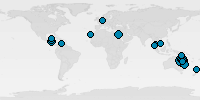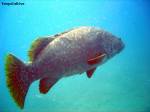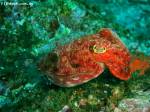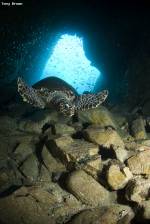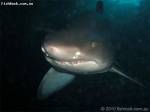Latest Dive Sites
Crystal Palace is one of the lesser dived dives around Rottnest Island, but certainly not less beautiful.

A list of the best rated scuba dive sites in Australia.
Yongala Wreck
While there are many shipwrecks along Australia's Great Barrier Reef, one of the best wreck dives is this one, the S.S. Yongala. This ship, made out of steel and timber, sank during a cyclone just about 60 kilometers from Townsville at Cape Bowling Green, taking the lives of all 121 passengers. The wreck lies in the middle of a flat and sandy shipping channel in about 30m of water. You can still see the aft, the rudder and forward masts, engine and steam rooms, toilets, port-holes and most of th...
Navy Pier at Exmouth
The Exmouth Navy Pier has been documented for some time. There have been collected thousands of photographs and hours of underwater material that reveal the variety of marine life that live around and beneath the Pier. Diving here near the Pier is considered to be amongst the top ten dive sites in Australia, and you can see more individual fish and species here, than most people will see in their lives! One of the reasons for this variety is that fishing from the Pier is prohibited and that the ...
Fish Rock Cave
The only true ocean cave dive in Australia is running 125 meters right through Fish Rock which lies two kilometers south-east of Smoky Cape, South West Rocks. Fish Rock Cave is home to a completely unique ecosystem. The temperature inside the cave is always at least one degree warmer than the surrounding ocean and the water is always clear. Although the Rock is usually prone to current, it is this current that brings the nutrients to the area and attracts the fish life. It is easy to plan your d...
Cod Hole
The Cod Hole is one of the best known dives in the world and it is visited by many liveaboard cruises out of Cairns and Port Douglas. It is famous because here you can dive with huge cods that are accustomed to divers and will come very close. The famous giant potato cod is still fed by dive masters. Dive down to the sandy floors area between the bommies, where you will see the fish feeding from beneath. Other marine species common in these waters are leopard morays and Maori wrasse, but it is t...
Snake Pit
Halfway between Lizard Island and Ribbon Reef nr 10 is a great dive site named Snake Pit. It lives up to its name as almost all divers encounter more than just one sea snake. The dive site is made up of 8 coral bommies roughly aligned in two lines and surrounded by a white sandy ocean floor. Many species of soft corals can be found, such as leather and palm corals. But there are also quite a few hard corals, sea fans, sponges and invertebrates such as clams, sea stars, nudibranches and sea cucu...
Osprey Reef
Osprey Reef is the most northern coral reef, situated far out on the edges of the Queensland Plateau, oval in shape and 25km times 12km in size. It is located more than 100km offshore and can only be reached by crossing the rough open sea on long multiple day liveaboard trips. In the middle of Osprey Reef is a 30m deep water lagoon, where the boats can safely anchor. Osprey Reef is constantly maintained by marine scientist and known for its abundant marine life. The fact that Osprey Reef is the...
Roe Reef
Roe Reef is one of the must dive sites at Rottnest Island and is located on the northeast end about 2 miles off shore. You will find some of the best limestone caves that I have ever found in the ocean here. Good fish life and good visibility, what more could you ask for. In a big swell you will find that you get some strong surge in the caves. This is a very popular area with boats so make certain that you have a good dive flag up and leave a lookout up on the boat. Dive Roe Reef when the ocea...
Bushrangers Bay
In 1982 the local diving community with much assistance from Fisheries achieved that which they had been pushing for a number of years; namely having Bushrangers Bay named as an Aquatic Reserve. Thus this much protected hourglass shaped bay has a lot to offer. Access to the bay is via a purpose built stairwell which leads onto a pebbled beach. This can be a spectacular dive with easy navigation due to the shape. The inner bay is only 5-6 meters maximum, following the channel into the outer bay d...
North Horn
Dive site North Horn is the northern most post of Osprey Reef. This part of the reef looks like a unicorn fish's horn, which explains its name. Currents, rich sea life, sharks feedings and the solitude of this dive site make it a perfect spot to meet sharks. Some of the species often seen are whitetips and silver reef sharks. But also hammerheads and tiger sharks occasionally come in to take a look. At 5 meter deep, the reef drops down almost vertical to 20 meter to continue to 40 meters deep f...
Black Head Reef
It's the little things in life that make this dive site special. Black Head Reef is a nice shallow dive made up of narrow gutters with high walls. There is a very diverse amount of marine life at this dive site, such as Wobbygong Sharks sleeping in the undercuts of the reef, schools of catfish swimming toward you in balls of up to 50 fish! There are occasional Grey Nurse Sharks, Stingrays, Southern Eagle Rays, Moray eels and hundreds of different species of fish, but the highlight of this dive i...
